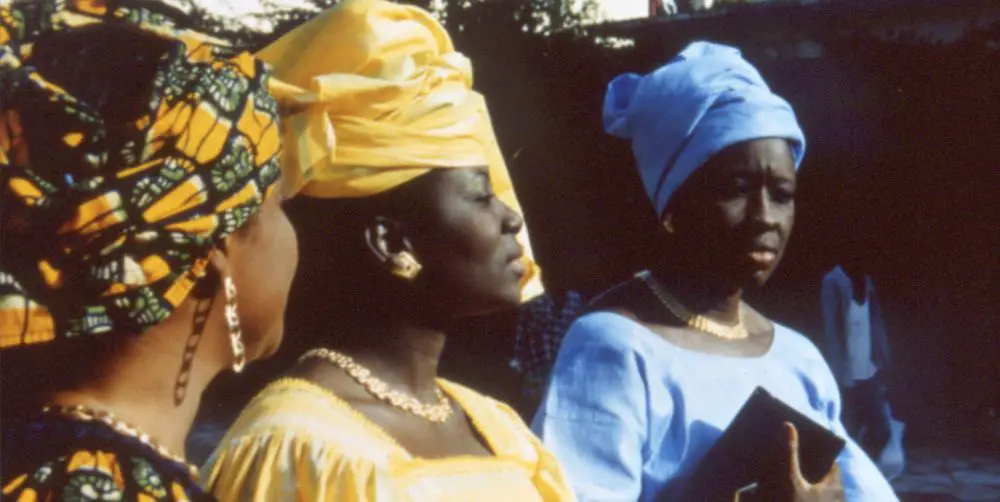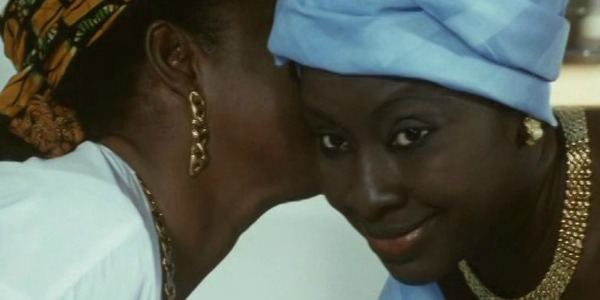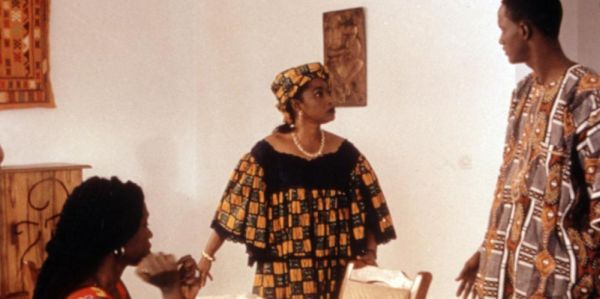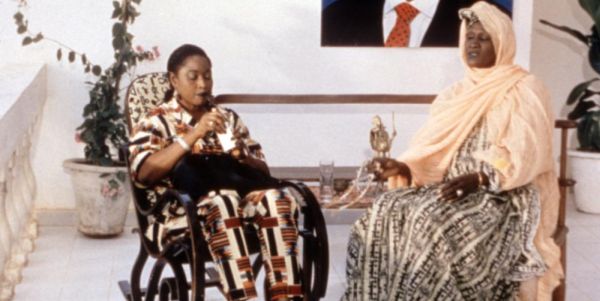FAAT KINÉ: Modernity In Motion

Ben is a former student of cognitive science who is…
The opening sequence of Ousmane Sembene‘s Faat Kiné shows us the complexity of urban motion in a place where modernity and traditionalism are still somewhat at odds. We see groups of women in traditional Senegalese dress walking through the city of Dakar. Then, the camera pulls further and further away from them until we can see can see a whole city block. We can see not only the women but also cars and other pedestrians, all moving in different directions. Some of the other people walking about are dressed like the women are; some are dressed in a more European style.
This sets the stage for the variety of different beliefs, lifestyles, and destinations that exist between the characters in Faat Kiné. By giving us such an understanding of its setting, the film also influences our perception of Kiné N’diaye Diop, its titular character. She frequently finds herself obstructed by archaic values, but thrives in modernity. It’s through her that the film renders an entertaining and thought-provoking slice of modern life in urban Senegal.
Assertive Mobility
Even after the opening scene, Faat Kiné emphasizes human movement through populated spaces. After confrontations occur between characters, the camera will often follow the people involved as they move away from where the confrontation took place. Alternatively, it’ll hold on compositions whose focal points shift as characters move in and out of the frame, contrasting different directions of movement. There are also many scenes similar to the opening, which showcase the grandiose network of movement that exists on the scale of the whole city.
Interactions between characters also involve a form of movement: the actors’ body language. Venus Seye, who plays Kiné, carries herself with upright confidence, and in scenes between Kiné and other characters, her body language tends to be more conspicuous: she gestures with her hands when she speaks, and expressively shifts her whole body.
The only characters who match Kiné in this regard are people close to her, other women who commiserate with her on problems of finance and traditional marriage. Moreover, when Kiné gets into disagreements with other characters, she often tells them where to move or otherwise influences their movements.

Another key element that makes Kiné stand out is her costuming. While most other characters exclusively wear either traditional Senegalese clothing or European clothing, Kiné changes her outfit periodically. Sometimes, she wears traditional clothes; other times, she combines traditional and European styles. This is perhaps appropriate, because the film situates her between generations, and one of her concerns in this film is balancing her past with her family’s future prospects: she hopes to secure a better future for her children while also ensuring that they understand the burdens placed on her in the past by traditionalist and exploitative men.
The narrative doesn’t have a lot of direction; things happen without much context, instead of unfolding from a coherent sequence of events. Faat Kiné is among the purest of slice-of-life films, and at two hours, it’s long enough that some may find this enervating. Even so, there’s something engaging and satisfying about seeing the rhythms of life in a place with such varied characters.
More importantly, there’s a lot of pathos in the Kiné’s relationship with her children, and her relationship with her own mother. Like some of Sembene’s other films, the emotional moments can sneak up on you once you get on the film’s wavelength.
Overlapping Competitors
In one scene, the camera pans over Dakar’s skyline while two sounds spread over the city: one is the Muslim call to prayer; the other is the ringing of Christian church bells. Muslims and Christians share the city, and while the tension between them never becomes one of the characters’ major problems, the film sometimes drops hints reminding us of its existence.
Kiné, for instance, is a Muslim, and consequently is apprehensive about marrying a Christian man. It doesn’t favor one side over the other, rather, it just exposes their coexistence and briefly notes some of the issues involved with it.
In fact, the film rarely seems to favor any one thing over others. Consider one of the most extreme scenes: that in which Kiné pepper sprays another woman for insulting her. The film has such a loose, slice-of-life story that this moment slips by without much resonating significance. There’s no music, and camera remains somewhere between the characters, capturing them more-or-less independently of their surroundings or of each other.

Instead of insisting that Kiné’s action here was righteous or unrighteous, the film leaves us to observe that it fits in with her other behavior: it’s aggressive, competitive, and unyielding. The film portrays these qualities as inherent to modern life, and tracks Kiné as she works out a place for herself as a modern person. The characters frequently compete and argue over which of them will get their way, and the outcome of any such conflict manifests in the characters’ movements.
That said, it’s worth noting that the act of competition itself does not play out in terms of movement, but in terms of words. The characters compete by impugning each other’s motives, coming up with justification their own actions, and hurling crude insults at one another. They quibble over names and the meanings of certain words, all while alternating between languages.
Words, Bodies, and Power
The relationship between people’s words – especially women’s words – and their freedom of bodily movement is a theme that also occurs in other films by Sembene. His first feature, the 1966 film Black Girl, derives remarkable tension from the dissonance between its main character’s aggrieved narration and the tedium of her assigned manual labor. You can also see it in his final film, 2004’s Moolaadé, when a group of cruel traditionalists attempt – unsuccessfully – to control a woman’s words by controlling her body.
Of course, the focus on women in Faat Kiné is equally significant, and is another thing it shares with many of Sembene‘s other films. His films often have feminist aims, and he held the belief that “when women progress, society progresses.” Films like Moolaadé or his 1971 Emitaï show women taking up causes that others won’t or can’t, and working to build a better future for their communities.

Kiné is not quite as influential on the world at large as the women of those films; after all, she works to position herself securely in modernity, rather than to promote a larger cause. Nevertheless, she does stand up to gendered oppression, and in doing so challenges the traditionalists’ notions of family and marriage.
To Conclude
Faat Kiné provides us with a notion of how people coexist in modern life. They’re in constant motion, and their values constantly compete for dominance. Elements of old, oppressive beliefs persist, but ultimately fall under the pressure of a capitalistic competition between ideals. That comes with its own problems, but at least affords some people a greater degree of freedom. The film seems cautiously optimistic about the future.
In any case, the warmth of Kiné’s familial love has us hoping for a better future in the end. At the same time, it suggests that reaching that requires an understanding of the past – and in light of the film’s oblique reference to Senegal’s colonial history, it’s more than just Kiné’s own past that demands understanding.
Does any particular detail of city life in Faat Kiné stand out to you?
Faat Kiné was first released in 2001, and is currently available to be streamed on Amazon Instant Video.
You can watch a brief preface and discussion of Faat Kiné here.
Does content like this matter to you?
Become a Member and support film journalism. Unlock access to all of Film Inquiry`s great articles. Join a community of like-minded readers who are passionate about cinema - get access to our private members Network, give back to independent filmmakers, and more.
Ben is a former student of cognitive science who is currently trying to improve his writing style and ability to understand and appreciate films containing unfamiliar perspectives. He tries not to hold films to a strict set of criteria, but does believe that strong movies can change your outlook on the world. His favorite films include Whisper of the Heart, Hellzapoppin', Foolish Wives, 42nd Street, and the work of Charlie Chaplin.













